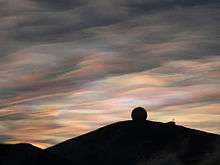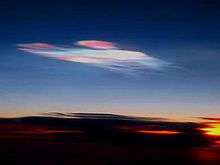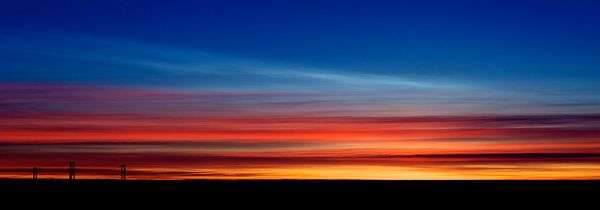Polar stratospheric cloud
| Polar Stratospheric Cloud | |
|---|---|
 Antarctic stratospheric cloud (nacreous clouds) | |
| Abbreviation | PSC |
| Altitude |
15,000–25,000 m (49,000–82,000 ft) |
| Classification | Other |
| Appearance | Glowing brightly with vivid iridescent colors |
| Precipitation cloud? | no |
Polar stratospheric clouds (PSCs), also known as nacreous clouds (/ˈneɪkriəs/, from nacre, or mother of pearl, due to its iridescence), are clouds in the winter polar stratosphere at altitudes of 15,000–25,000 m (49,000–82,000 ft). They are best observed during civil twilight, when the Sun is between 1 and 6 degrees below the horizon, as well as in winter and in more northerly latitudes.[1] They are implicated in the formation of ozone holes.[2] The effects on ozone depletion arise because they support chemical reactions that produce active chlorine which catalyzes ozone destruction, and also because they remove gaseous nitric acid, perturbing nitrogen and chlorine cycles in a way which increases ozone depletion.[3]
Formation
The stratosphere is very dry; unlike the troposphere, it rarely allows clouds to form. In the extreme cold of the polar winter, however, stratospheric clouds of different types may form, which are classified according to their physical state and chemical composition.[4]
Due to their high altitude and the curvature of the surface of the Earth, these clouds will receive sunlight from below the horizon and reflect it to the ground, shining brightly well before dawn or after dusk.
PSCs form at very low temperatures, below −78 °C (−108 °F). These temperatures can occur in the lower stratosphere in polar winter. In the Antarctic, temperatures below −88 °C (−126 °F) frequently cause type II PSCs. Such low temperatures are rarer in the Arctic. In the Northern hemisphere, the generation of lee waves by mountains may locally cool the lower stratosphere and lead to the formation of PSCs.
Forward-scattering of sunlight within the clouds produces a pearly-white appearance. Particles within the optically thin clouds cause colored interference fringes by diffraction. The visibility of the colors may be enhanced with a polarising filter.[1][5]
Types

PSCs are classified into three types Ia, Ib and II according to their chemical composition which can be measured using LIDAR. The technique also determines the height and ambient temperature of the cloud.[5]
- Type I clouds contain water, nitric acid and/or sulfuric acid and they are a source of polar ozone depletion.[6]
- Type Ia clouds consist of large, aspherical particles, consisting of nitric acid trihydrate (NAT).[5]
- Type Ib clouds contain small, spherical particles (non-depolarising), of a liquid supercooled ternary solution (STS) of sulfuric acid, nitric acid and water.[5]
- Type Ic clouds consist of metastable water-rich nitric acid in a solid phase.[7]
- Type II clouds, which are very rarely observed in the Arctic, consist of water ice only.[5]
Only Type II clouds are necessarily nacreous[1] whereas Type I clouds can be iridescent under certain conditions, just as any other cloud.
See also

References
- 1 2 3 "Polar stratospheric clouds / Observations". Australian Antarctic Division.
- ↑ "Why is the ozone hole over Antarctica?". United States Environmental Protection Agency. Archived from the original on 2006-09-30.
- ↑ "Scientific Assessment of Ozone Depletion" (PDF). World Meteorological Organization. 2002. particularly section 3.2.2 (pages 3.21, i.e. 195 of the PDF file, and following).
- ↑ Lowe, Douglas; MacKenzie, A. Robert (2008). "Polar stratospheric cloud microphysics and chemistry" (PDF). Journal of Atmospheric and Solar-Terrestrial Physics. 70: 13. Bibcode:2008JASTP..70...13L. doi:10.1016/j.jastp.2007.09.011.
- 1 2 3 4 5 Maturilli, Maturilli. "Polar Stratospheric Clouds Above Spitsbergen". Alfred Wegener Institute for Polar and Marine Research. Archived from the original on 2007-08-24.
- ↑ "Nacreous and Polar Stratospheric Clouds". atoptics.co.uk.
- ↑ "The presence of metastable HNO3/H2O solid phases in the stratosphere inferred from ER 2 data" (PDF). Journal of Geophysical Research.
External links
| Wikimedia Commons has media related to Polar stratospheric cloud. |
Research
- Nacreous Clouds at atoptics.co.uk
- Polar Stratospheric Clouds Above Spitsbergen at Alfred Wegener Institute